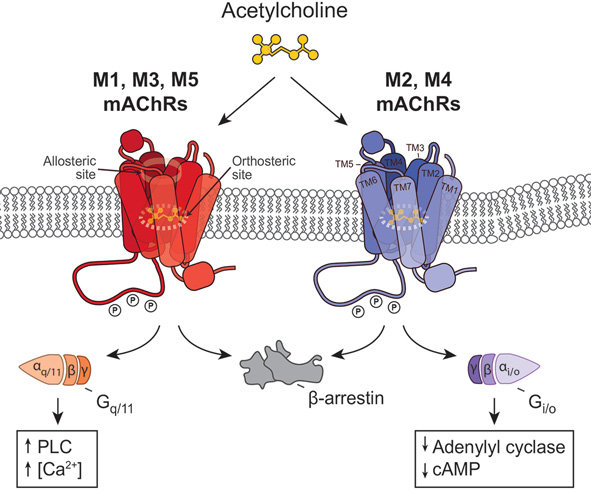-
muscarinic receptor antagonist
Biperiden hydrochloride 是一种毒蕈碱受体拮抗剂,对 M1 亚型显示出一定的选择性。 -
AChR antagonist
Fesoterodine fumarate 是一种药物,用于治疗尿急,减少排尿次数和急迫性尿失禁。 -
mAChR M2 antagonist
Gallamine Triethiodide 是一种具有显著心脏选择性的 mAChR M2 拮抗剂。 -
muscarinic receptor antagonist
SVT-40776 是一种新型的 M3 muscarinic receptor antagonist,用于治疗 overactive bladder。 -
muscarinic acetylcholine receptor (mAChR) antagonist
Tiotropium Bromide (BA679 BR) 是一种毒蕈碱型乙酰胆碱受体(mAChR)拮抗剂,它阻止乙酰胆碱配体的结合和随后的配体门控离子通道的开启。 -
muscarinic receptor antagonist
托特罗定酒石酸盐(Detrol LA)是一种毒蕈碱受体拮抗剂,用于治疗尿失禁。 -
muscarinic receptor antagonist
5-羟甲基托特罗定是托特罗定的代谢产物,托特罗定是一种用于治疗尿失禁的毒蕈碱受体拮抗剂。 -
NMDA receptor antagonist
奥芬那林柠檬酸盐是一种 NMDA 受体拮抗剂,其Ki值为6.0 +/- 0.7 μM,同时也是 HERG 钾通道阻断剂。 -
acetylcholine receptor antagonist
Beperidium iodide 表现出对乙酰胆碱受体的竞争性拮抗作用,其 pA2 值为 7.93。 -
Muscarinic receptor antagonist
溴化乌美克利尼(GSK573719A)是一种毒蕈碱受体拮抗剂,用于治疗慢性阻塞性肺病(COPD)。 -
muscarinic receptor antagonist
Revefenacin 是一种强效且选择性的毒蕈碱受体拮抗剂,目前正在开发中,用于治疗慢性阻塞性肺病(COPD)。 -
muscarinic antagonist
Anisotropine methylbromide 是一种胆碱能拮抗剂和抗痉挛药。Anisotropine methylbromide 是一种季铵化合物。它作为消化性溃疡治疗辅助药物的使用已被更有效的药物所取代。 -
Muscarinic antagonist
Procyclidine hydrochloride 是一种 muscarinic antagonist,能够穿过 blood-brain barrier,用于治疗药物引起的 extrapyramidal disorders 和 Parkinsonism。 -
Muscarinic antagonist
Mepenzolate Bromide 是一种胆碱能拮抗剂,用于治疗胃肠道疾病。它可以减轻由弹性蛋白酶引起的气腔扩大和呼吸功能障碍的严重程度。 -
M1 muscarinic receptor antagonist
Pirenzepine dihydrochloride (LS519) 是一种选择性的 M1 muscarinic receptor antagonist。 -
mAChR antagonist
阿托品甲基溴化物是一种毒蕈碱受体(mAChR)拮抗剂,它是阿托品的季铵盐,并用作眼科检查时扩张瞳孔的散瞳剂。由于其高极性特性,该药物用于缓解婴儿的幽门痉挛。与阿托品相比,它不容易渗透到中央神经系统中。 -
mAChR antagonist
mAChR-IN-1 hydrochloride 是一种强效的毒蕈碱胆碱能受体(mAChR)拮抗剂,其 IC50 为 17 nM。 -
M3 muscarinic receptor antagonist
Tarafenacin D-tartrate (SVT-40776 D-tartrate) 是一种高度选择性的 M3 muscarinic receptor antagonist(Ki= 0.19 nM),对 M2 receptor 的选择性约为200倍。 -
muscarinic antagonist
Aclidinium Bromide(LAS 34273;LAS-W 330)是一种长效吸入型毒蕈碱拮抗剂,用作慢性阻塞性肺病(COPD)的维持治疗。 -
muscarinic acetylcholine receptor antagonist
Benzetimide hydrochloride 是一种胆碱能受体拮抗剂。 -
mAChR antagonist
Nor-benzetimide 是 Benzetimide 的主要代谢物。Benzetimide 是一种具有抗胆碱能活性的 mAChR 拮抗剂。
mAChR


Muscarinic acetylcholine receptors (mAChRs) are a class of G protein-coupled receptors (GPCRs) found in the central and peripheral nervous systems, as well as in various other tissues and organs throughout the body. These receptors are named after muscarine, a natural alkaloid compound found in certain mushrooms, which was one of the first substances discovered to activate them.
There are five subtypes of muscarinic receptors, designated as M1 through M5, each with distinct tissue distribution and functions. Here's an overview of their roles:
- M1 Receptors: Predominantly found in the central nervous system, particularly in regions associated with cognitive functions. Activation of M1 receptors is linked to memory and learning.
- M2 Receptors: Found in the heart, where they play a crucial role in regulating heart rate and cardiac contractility. Activation of M2 receptors slows heart rate and reduces the force of cardiac contractions.
- M3 Receptors: Present in smooth muscle tissues, such as those in the gastrointestinal tract, urinary bladder, and bronchial airways. Activation of M3 receptors leads to smooth muscle contraction.
- M4 Receptors: Distributed mainly in the central nervous system and involved in modulating neurotransmitter release. Their role in cognition and neuropsychiatric disorders is of interest.
- M5 Receptors: Located in certain areas of the brain and implicated in the modulation of dopamine release. Research suggests they may be relevant to Parkinson's disease and addiction.
Muscarinic receptors are activated by the neurotransmitter acetylcholine and play a vital role in regulating a wide range of physiological processes, including heart rate, smooth muscle contraction, glandular secretion, and neurotransmitter release. They are targets for various drugs, including anticholinergic agents, which block their activity, and drugs used to treat conditions like bradycardia and neurodegenerative disorders.
Understanding the functions and regulation of muscarinic acetylcholine receptors is essential for developing therapies that modulate their activity and for advancing our knowledge of how they contribute to various physiological and pathological processes in the body.



